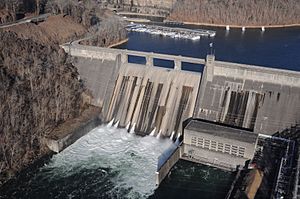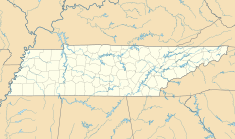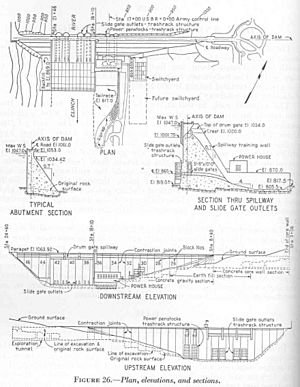Norris Dam facts for kids
Quick facts for kids Norris Dam |
|
|---|---|

Norris Dam
|
|
|
Location of Norris Dam in Tennessee
|
|
| Official name | Norris Dam |
| Location | Anderson County and Campbell County, Tennessee, United States |
| Coordinates | 36°13′27″N 84°05′29″W / 36.22417°N 84.09139°W |
| Construction began | October 1, 1933 |
| Opening date | March 4, 1936 |
| Operator(s) | Tennessee Valley Authority |
| Dam and spillways | |
| Impounds | Clinch River |
| Height | 265 feet (81 m) |
| Length | 1,860 feet (570 m) |
| Reservoir | |
| Creates | Norris Lake |
| Total capacity | 2,552,000 acre⋅ft (3,148,000 dam3) |
| Catchment area | 2,912 sq mi (7,540 km2) |
| Power station | |
| Commission date | 1936 |
| Turbines | 2 x 66 MW Francis-type |
| Installed capacity | 132 MW |
The Norris Dam is a huge structure built on the Clinch River in Tennessee, USA. It helps create electricity from water (called hydroelectric power) and also stops floods. This dam was the very first big project for the Tennessee Valley Authority (TVA). The TVA was started in 1933 to help the area grow and to control the many floods that used to happen in the Tennessee Valley.
The dam is named after Nebraska Senator George Norris. He was a big supporter of government-owned power and the TVA. The dam's buildings and structures were added to the National Register of Historic Places in 2016 because of their importance.
Norris Dam is made of concrete and is very strong. It is 1,860 feet (570 meters) long and 265 feet (81 meters) high. The dam creates Norris Lake, which is the biggest lake on a river that flows into the Tennessee River. The lake has a water surface of 33,840 acres (137 square kilometers) and 809 miles (1,302 kilometers) of shoreline. The dam can produce up to 126 megawatts of electricity.
Contents
Where is Norris Dam Located?
The Clinch River flows for about 300 miles (480 km) from its start in Virginia through the hills of northeastern Tennessee. It then joins the Tennessee River near Kingston. Norris Dam is built about 79 miles (127 km) upstream from where the Clinch River meets the Tennessee River. It is just below where Cove Creek joins the Clinch River.
The large lake formed by the dam, Norris Lake, covers parts of Anderson, Campbell, Union, Claiborne, and Grainger counties. Norris Lake stretches for 73 miles (117 km) along the Clinch River. It also covers the lower 56 miles (90 km) of the Powell River, which flows into the Clinch River about 10 miles (16 km) upstream from the dam. The water flowing out of Norris Dam becomes part of Melton Hill Lake.
A road called Norris Freeway, which is part of U.S. Highway 441, goes right over the top of Norris Dam. This road was made wider in the 1930s to help with building the dam. It connects the dam area to Interstate 75 and cities like Knoxville, Tennessee. Much of the land around Norris Lake is protected. This includes Norris Dam State Park, the Cove Creek Wildlife Management Area, and the Chuck Swan State Forest.
How Norris Dam Was Built
People knew as early as 1911 that the "Cove Creek site," where Norris Dam now stands, was a great spot for a large dam. Many groups, both government and private, thought a dam here could help control floods in East Tennessee. It could also keep the Tennessee River deep enough for boats all year.
In the 1920s, some private companies wanted to build a dam at this site. However, Senator Norris believed the government should build it. He argued that a private company would only care about making electricity, not about controlling floods or working with other projects in the valley. Senator Norris wanted a system of dams across the entire valley to manage the water flow. The U.S. Army Corps of Engineers also suggested building a dam here, but Congress or President Calvin Coolidge rejected their plans.
The Role of the TVA and New Deal
The Tennessee Valley Authority (TVA) was created in 1933. This was part of President Franklin D. Roosevelt's "New Deal" plan to help the country recover from the Great Depression. The law that started the TVA said they should immediately begin building a dam at the Cove Creek site. On July 30, the TVA decided to name the project Norris Dam, after Senator Norris.
Since the TVA was new, it didn't have much experience building dams. So, it used the Army Corps' original design and got a lot of advice from the U.S. Bureau of Reclamation. A Hungarian-American architect named Roland Wank updated the plans. He gave Norris Dam a modern look, which was quite new for that time. Construction of the dam began on October 1, 1933.

Building Norris Dam and its lake meant buying over 152,000 acres (61,500 hectares) of land. About 2,841 families and 5,226 graves had to be moved. The town of Loyston, which was about 20 miles (32 km) upstream, was completely covered by water. Part of Caryville was also flooded, and some buildings there had to be moved.
The Civilian Conservation Corps, a program that employed young men during the Great Depression, helped build parks and move structures. The town of Norris, Tennessee was specially built as a planned community to house the workers who built the dam.
Norris Dam was finished and its gates were closed on March 4, 1936. It cost $36 million to build. The dam's first generator started making electricity on July 28, 1936. Even though Norris was the first dam built by the TVA, it's not the oldest dam they own. The TVA later bought other dams that were built before Norris Dam.
The building of Norris Dam and the changes it brought to the area inspired many creative works. These included films, books, plays, and folk songs. The songs from that time showed how excited people were about the benefits the dam brought. Many famous people visited the dam, including President Franklin D. Roosevelt and First Lady Eleanor Roosevelt, and Indian Prime Minister Jawaharlal Nehru. In 1941, the dam was even featured in a photography exhibit at the Museum of Modern Art in New York.
- Norris Dam in the Structurae database
Images for kids
-
Curt Stiner, a farmer from the Sharps Chapel area, was one of the people who had to move because of Norris Dam. He felt he had to sell his farm to TVA for less than he had paid for it, even after building new farm structures.





